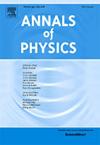13 TeV质子-质子碰撞中热力学参数的多重依赖行为
IF 3
3区 物理与天体物理
Q2 PHYSICS, MULTIDISCIPLINARY
引用次数: 0
摘要
我们利用热力学一致的Tsallis分布分析了13tev质子-质子碰撞中产生的已识别粒子的横向动量谱。同时提取了冷冻体积V和有效温度T。能量密度(η),粒子数密度(n),压力(P),声速平方(cs2)和熵密度(s)是计算的其他热力学量之一。上述参数是相对于多重性类别提出的,并且预计随着多重性类别的增加而减少。声速的平方在前几个多重级中逐渐减小,然后急剧减小。此外,不同的粒子被观察到有不同的冻结面,但所有的粒子被观察到有相同的热化。进一步,我们显示了各参数之间的相关性,均为正相关。无量纲参数([/T4])与T、< dNch/dη >和T、< dNch/dη >和cs2的相关性突然变化,这可能表明强子物质向夸克-胶子等离子体(QGP)相变。cs2与T的相关性与晶格量子色动力学(LQCD)的预测结果接近。本文章由计算机程序翻译,如有差异,请以英文原文为准。
Multiplicity dependent behavior of thermodynamic parameters in proton–proton collisions at 13 TeV
We analyze transverse momentum spectra of identified particles produced in proton–proton collisions at 13 TeV using the thermodynamically consistent Tsallis distribution. Both the freezeout volume () and the effective temperature () are extracted. The energy density (), particle number density (), pressure (), squared sound speed (), and entropy density () are among the other thermodynamic quantities that are computed. The aforementioned parameters are presented in relation to the multiplicity class and are expected to decrease as the multiplicity class increases. The squared speed of sound decreases gradually in the first few multiplicity classes, and then it decreases sharply. Besides, different particles are observed to have different freezeout surfaces, but all particles are seen to have the same thermalization. Furthermore, we displayed the correlations between the various parameters, all showing positive correlations. There is a sudden change in the correlations of the non-dimensionless parameter () and , and , and and , which may show the phase transition from hadronic matter to quark–gluon plasma (QGP). The result of the correlation between and is close to the Lattice Quantum Chromodynamic (LQCD) prediction.
求助全文
通过发布文献求助,成功后即可免费获取论文全文。
去求助
来源期刊

Annals of Physics
物理-物理:综合
CiteScore
5.30
自引率
3.30%
发文量
211
审稿时长
47 days
期刊介绍:
Annals of Physics presents original work in all areas of basic theoretic physics research. Ideas are developed and fully explored, and thorough treatment is given to first principles and ultimate applications. Annals of Physics emphasizes clarity and intelligibility in the articles it publishes, thus making them as accessible as possible. Readers familiar with recent developments in the field are provided with sufficient detail and background to follow the arguments and understand their significance.
The Editors of the journal cover all fields of theoretical physics. Articles published in the journal are typically longer than 20 pages.
 求助内容:
求助内容: 应助结果提醒方式:
应助结果提醒方式:


